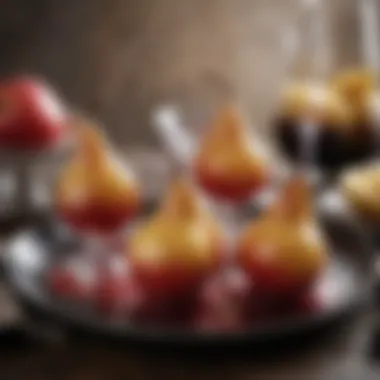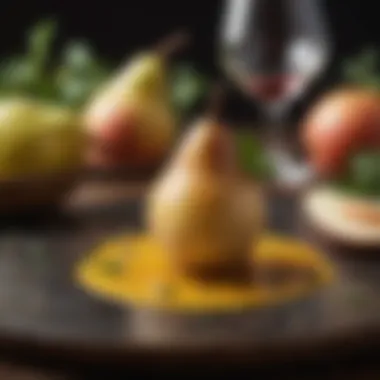Exploring Pears in Wine: A Culinary Journey of Flavor


Intro
The involvement of pears in wine transcends mere flavor enrichment; it represents a meticulous confluence of cooking and cultural history. This affinity goes back to ancient times, where these fruits were cherished not only for their taste but also for their aromatic properties. In the modern culinary realm, marrying pears with various wines adds layers of complexity to both the fruit and the beverage. Understanding how to utilize this ingredient will enhance various dishes. Whether you are an avid home cook or a seasoned chef, this guide opens the door to an age-old culinary journey.
Ingredients Breakdown
In exploring the art of integrating pears within a wine context, it is crucial to comprehend the ingredients involved, ranging from primary elements to optional accompaniments.
Primary Ingredients
- Pears - The primary fruit, highly recommended varieties include:
- Wine - Type of wine will depend on the desired outcome. Suggested wines include:
- Bartlett: Its sweet flavor is enhanced when cooked.
- Bosc: Holds shape well and adds unique flavor notes.
- Anjou: Offers versatility in both desserts and savory dishes.
- Riesling: Known for its sweetness, complements pears effectively.
- Pinot Grigio: Offers a crisp mouthfeel that balances the softness of pears.
- Red blends: Can add depth and complexities.
Optional Ingredients
- Spices: Cinnamon, nutmeg, or star anise amplify the aromatic profile.
- Sweeteners: Honey or sugar can adjust the sweetness appropriately.
- Citrus Zest: Adds freshness and heightens the taste.
Essential Kitchen Tools
Every kitchen needs certain tools for effective preparation:
- Sharp Knife: For slicing and peeling.
- Cutting Board: Provides a safe space to work on.
- Saucepan: Ideal for simmering pears and wine.
- Serving Dish: To present the finished dish.
By cataloging these components, cooks will attain not only the requisite materials but also an understanding of balance in flavors and textures critical to executing a satisfactory result.
Step-by-Step Preparation
Preparation is vital for a successful dish wherein pears are infused with wine. The subsequent steps demystify this process, guiding cooks from ingredient handling to final presentation.
Prepping the Ingredients
Start by selecting unblemished, ripe pears. Begin the peeling process and slice the pears into uniform segments to ensure even cooking.
- Rinse the pears to remove any residual wax or dirt.
- Cut the cheeks away from the core, retaining as much fruit as possible.
Cooking Techniques and Methods
Cooking techniques may vary based on the chosen recipe. Here are some common methods:
- Poaching: A preferred method, where pears are gently simmered in a mixture of wine, sugar, and spices until tender. The liquid should barely bubble.
- Baking: For a more caramelized outcome, baked pears in red wine are drizzled with honey prior to cooking.
Assembly and Presentation Tips
Plate the dish artfully for maximum visual impact. Twirl sliced pears stylishly around a swirl of sauce. A sprinkle of fresh herbs, such as mint, can also provide a ligh touch.
Understanding Pears in Culinary Context
Incorporating pears into culinary practices extends far beyond simple garnishes or side dishes. Understanding how pears interact with ingredients, both in terms of flavors and textures, forms a vital aspect of gastronomy. This knowledge enhances dishes significantly and elevates the dining experience. In the context of cooking pears in wine, the appreciation of their subtle sweetness and unique acidity plays a crucial role. This exploration aims to deepen comprehension for culinary enthusiasts, allowing them to appreciate the relationship between pears and wine.
Historical Background
Pears have a storied history in culinary traditions that date back thousands of years. Ancient civilizations cultivated various pear species, often linking the fruit to fertility and health. The Romans loved pears for their sweetness and used them in numerous recipes. Historical texts from the Middle Ages reflect innovations that integrated pears with wines, developing a combination that affected further culinary practices. This historical context is rich with stories of trade and the impact of horticulture on the culinary landscape.
Culinary Significance
The culinary significance of pears cannot be emphasized enough. Their ability to complement a variety of flavors makes them a versatile ingredient. Many devoted chefs recognize pears' aptitude for balancing flavors, particularly their interaction with the tannins and sugars in wine. When pears are included in wine, they not only absorb the rich liquid but enhance their inherent flavors. This symbiosis provides a depth to dishes that few other ingredients can offer. Moreover, their textural contrast, when properly prepared, brings an interesting dynamic to sauces and sides.?1. Often seen in both sweet and savory dishes, pears inspire creativity in how they can be paired with ingredients, including nuts, cheeses, or even delicate herbs.
Understanding these facets helps uncover the essence of pears in culinary applications, making this knowledge advantageous for those looking to explore its broader implications in the art of cooking.


Types of Pears Suitable for Wine Infusion
Understanding the types of pears suitable for wine infusion is crucial in achieving a delightful culinary experience. Selecting the right variety enhances the overall flavor profile and contributes to the dish's depth. Certain pears express flavors that can harmonize wonderfully with various types of wines, making them particularly enjoyable in culinary applications. Moreover, the choice of pears can affect how well they absorb the wine's aromatics during the cooking process.
Common Varieties
When considering pears for infusion, you should explore specific varieties that lend themselves well to cooking with wine. Here are some notable types commonly used:
- Bosc Pears: With their firm texture and subtly sweet flavor, Bosc pears are excellent in wine-infusing preparations. They hold their shape well during cooking while absorbing flavors from the wine.
- Anjou Pears: Another versatile choice, Anjou pears can be delightful when cooked, offering a mildly sweet taste. Their juicy flesh becomes tender and lightens when simmered with wine.
- Bartlett Pears: Commonly found in many regions, Bartlett pears have a fragrant aroma and sweet flavor, which can elevate wine sauces or reductions.
These varieties complement various wine types, each contributing its unique character. Kitchen-savvy enthusiasts appreciate how carefully selecting pears enhances dishes in unexpected ways.
Seasonality and Selection
The seasonality of pears plays a significant role in holidaying the ideal fruit for cooking with wine. Harvest timings can affect freshness and quality, making awareness of these timings necessary for ingredients:
- Summer into Early Fall: Most pears are generally harvested in late summer and into early fall, providing options like Bartlett and Bosc at their prime.
- Ripeness: Choose pears that are slightly under ripe. Ripe pears tend to become overly mushy during cooking, while firmer ones offer well-defined structure and texture in cooked dishes.
When selecting pears, pay attention to local markets or farms that provide seasonal produce. The benefits include improved flavor while supporting local agriculture. Furthermore, opting for organic or sustainably grown pears ensures you embrace culinary practices that align with holistic eating.
Epilogue
In summary, conscientious selection of pears is integral to enhancing culinary endeavors, especially when paired with wine. By leaning into seasonality and noteworthy attributes of various pear varieties, cooks can expertly elevate the flavors in their dishes.
The Process of Cooking Pears in Wine
Cooking pears in wine is a nuanced process that adds sophistication to both the fruit and the beverage. The act of cooking introduces a depth of flavor, transforming the simple pear into a centerpiece for various dishes. The combination of pears and wine showcases a harmonious relationship that enhances meals, making it essential for culinary enthusiasts to understand the process in detail. Through the correct approach, one can elevate everyday cooking to an art form.
Essential Ingredients
When embarking on the culinary journey of cooking pears in wine, selecting the right ingredients is critical. The primary ingredient, of course, is the pear. For this purpose, varieties like Bosc or Anjou are particularly suitable due to their firm texture. Aside from pears, the wine selected is equally important. Choosing a robust red, such as Merlot, or a fragrant white like Riesling can significantly affect the outcome. This duality not only adds layers of flavor, but also creates a colorful presentation.
Additional elements may include:
- Sweeteners like sugar or honey to enhance flavor
- Spices such as cinnamon or star anise to introduce warmth
- Zest or citrus juices that can cut through the richness of the dish
By selecting wisely, the culinary experience becomes more rewarding.
Preparation Techniques
Preparation is as important as the cooking itself. It sets the foundation for a well-executed dish. Pears must be prepped properly to maximize flavor absorption during cooking.
Peeling and Coring
Peeling and coring are fundamental when preparing pears for an infusion in wine. This technique not only enhances the texture but allows wine and spices to penetrate more effectively. Removing the skin means less bitterness, letting the authentic flavour of the pear shine. Additionally, cored pears present nicely in dishes, improving the aesthetic from a visual perspective. Although many global cuisines embrace unpeeled fruit, this method suits wine infusion as it helps to concentrate the flavor absorption.
Chopping and Slicing
Chopping and slicing create varied textures, providing an opportunity to showcase individual flavors more prominently. The slices allow for a more rapid infusion of the chosen wine, offering a distinct taste in every bite. Cutting pears into small pieces raises surface area, which ensures that every morsel gets coated in the aromatic liquid. However, it is essential to maintain uniformity in size for even cooking. Uneven pieces can lead to discrepancies in texture, impacting the overall quality of the dish.
Cooking Methods
How you choose to cook pears in wine can affect both texture and flavor. Various methods exist, each providing a unique profile and experience.
Simmering
Simmering pears in wine yields a balanced result, with soft fruit gently melded in the rich flavors of the liquid. This slow method allows time for the infusion, creating tender fruit adorned with luscious and inspired tastes. The long exposure to warmth can help achieve delicate caramelization, resulting in mingled flavors. Caution is advised—too high heat can lead to overly mushy pears.
Braising
Braising is another cooking technique welcomed in pears-in-wine recipes. This involves cooking off moisture first to develop a complex flavor, followed by adding wine. The combination leads to deeply flavored, luscious pears, creating a delightful interplay of juices and fortifying the nutrient profile. Key to this method is patience; allowing layers to meld takes longer, yet the outcome pays off with concentrated flavors. Understanding these cooking methods dramatically enhances the experience of pears prepared in wine.
Exploring the various cooking styles enriches both experience and flavor options, reinforcing the culinary significance of pears in wine.


Flavor Combinations with Pears and Wine
Exploring flavor combinations is essential for maximizing the culinary potential of pears in wine. This section dives into various elements that work well together, enhancing the overall dish's appeal and taste. Understanding these partnerships can elevate any cooking experience, guiding both novice and seasoned chefs in harmonious flavor profiles.
Herbs and Spices
The addition of herbs and spices can transform the ennui of a dish into a vibrant experience. Pears, with their subtle sweetness, paired with wine, create an excellent canvas for such flavoring. Common herbs like thyme and rosemary can impart a refreshing quality, contrasting nicely against the natural sweetness of the fruit.
Spices bring another level of depth. Consider using cinnamon or star anise; their warm notes complement the wine and blend beautifully with the sugary notes of ripe pears. When working with wine, particularly chefs often lean toward spices like nutmeg or cardamom for an unexpected twist.
Key considerations include:
- Complex flavor profile: The goal is to enhance, not overwhelm.
- Balance: Each element needs to harmonize, paying attention to the overall flavor dynamics.
Cheeses and Accompaniments
Pairing cheese with pears cooked in wine yields a rewarding culinary union. Soft, creamy cheeses like Brie or Goat cheese pair well with the sweet and tart notes present in a wine-infused pear dish. Additionally, some sharper cheeses like blue cheese provide a striking contrast that heightens flavors.
Accompaniments go beyond cheese. Nuts such as walnuts or almonds add an important crunchy textural contrast while working with both pears and wine flavors. Breads, especially artisanal loafs, can serve as a foundation for creating dimension in a dish. Here is a breakdown of excellent pairings:
- Soft cheeses: Brie, Goat cheese
- Sharp cheeses: Blue cheese, Parmesan
- Nuts: Walnuts, Almonds
- Breads: Sourdough, Baguette
Great flavor combinations challenge the palate yet thrill your senses. Approaching the pairing of pears and wine with precision makes the cooking journey truly enjoyable and explorative.
Wine Selection for Cooking with Pears
Choosing the right wine for cooking with pears is essential. The selected wine defines the dish's overall flavor, impacting the synergistic relationship between the pears and the other elements in the recipe. Different wines bring distinct characteristics that can enhance or dominate the pears’ natural sweetness. Thus, understanding how to choose wine wisely serves as a pivotal skill for achieving culinary excellence.
When cooking pears, identifying the type of dish you want to create is important. Whether aiming for a light dessert or a more savory main course, the type of wine will guide the result. Aspiring chefs should allow the fruit to shine while complementing its flavors with the selected wine.
Red vs.
White Wines
The debate surrounding red and white wines is notable in both culinary settings and personal dining choices. Each type carries its strengths when paired with pears.
- White wines:
- Red wines:
- Such as Chardonnay or Riesling, amplify the delicate sweetness of the pears.
- The bright acidity in white wines balances the fruit’s sugar, allowing for rich, nuanced dish development.
- Options like Merlot and Cabernet Sauvignon can infuse deeper notes to the dish.
- The bold flavors can provide contrast, creating depth, especially when using pears meant for more savory applications.
Utilizing white or red wine summarizes personal taste preferences, though balance remains crucial. Cooking with both allows for exploration and novelty in flavor profiles.
Regional Wine Pairings
Understanding how local climates and cultural traditions influence wine selection enhances the cooking experience. Each cuisine often boasts distinctive wine norms that cater well to their regional pear varieties.
- French Cuisine:
- Italian Approaches:
- Asian Influences:
- Utilizes Vins Blancs like Sancerre or Monbazillac for hints of floral notes and elevated sweetness, often referred to as a classic combination with poached pears.
- Pairing pears with Prosecco provides a different culinary artistry accentuating the festive and refreshing aspects of the fruit.
- Explore the use of rice wines, such as Shaoxing, which create an intriguing balance with sweetness.
Choosing wine shaped by regional identity adds a meaningful narrative to the overall culinary journey. Understanding these elements expands the repertoire of every ambitious home cook.
The selection of wine while cooking does not merely represent personal choice but serves as a bridge between cultural ingredients and traditional dishes.
Cultural Variations of Pears in Wine
Pears in wine reflects a cultural tapestry that can vary significantly across different culinary traditions. Understanding these variations enriches one's own cooking and broadens appreciation for global cuisines. When we explore how pears are paired with wine in various cultures, it showcases the creativity and adaptability of cooking practices that stem from simple, local ingredients.


French Cuisine
In France, pears in wine are often presented as a sophisticated dessert or a refined element of a cheese platter. Classic recipes like poire au vin involve poaching pears in red wine, typically enhanced with spices such as cinnamon and star anise. The French focus heavily on elevating natural flavors while embracing the aromatic nature of wine.
The pairing balances sweet and tart notes, serving as a delightful end to a meal. Furthermore, regions like Provence even experiment with different wine varieties for poaching, showcasing a range of fruitful creativity. Here, the quality of wine is paramount; a full-bodied wine like Merlot will add depth to the fruit, while a more delicate Pinot Noir allows the pears’ natural sweetness to remain unmasked.
Italian Approaches
Italy offers another lens through which to appreciate pears in wine. Italian chefs often incorporate pears as integral components in savory dishes. Cuisines from regions like Tuscany include pears in red wine reduction served with various meats, adding a sweet contrast to rich flavors. Additionally, candied or roasted pears can emerge in desserts such as tarts or gelato toppings.
The use of wine is also very Italian-local; Chianti or Barbera are frequent choices, making seamless ties with regional products. Traditional cooking norms often combine seasonal fruits with local wines, ensuring freshness and local authenticity.
Asian Influences
The use of pears in wine can also be seen in various Asian cuisines. Chinese culinary practices often feature the pairing particularly in festive occasions. Pears, included in numerous herbal teas, can be simmered in rice wine, valued for its crisp flavor culture, medicinal properties, and health benefits. This reflects the philosophical traditions regarding food in Asian societies, where items serve dual offerings of taste and health.
Japanese cuisine has shown similar tendencies, where pears may complement sake in sweet dishes. Combining flavors comes not only from science but also from vast cultural exchange between taste preferences and cooking methods across Japan and China, layering minimalism with richness found in richer ingredients like pears and wine.
In summation, the cultural variations enrich the culinary landscape of pears in wine. Each approach represents how local ingredients meld seamlessly with regional wines presenting popular possibilities. Food enthusiasts can take cues from these traditions for using familiar fruit in inventive, dynamic ways.
Serving Suggestions
Serving suggestions are critical when discussing pears in wine. These ideas highlight the pairing benefits, enhance the overall dining experience, and encourage creative uses of this unique combo. Incorporating pears thoroughly immersed in wine expands the culinary landscape. Each presentation can attract diverse palates, enriching flavors and textures for a range of dishes. Let’s explore specific flows of enjoyment in both appetizer and dessert settings.
Appetizer Courses
Appetizers often serve as the initial impression before the main course. Using pears and wine in this setting allows cooks to craft introducing sensations. Consider a pear and gorgonzola salad drizzled with a white wine vinaigrette. The sweets of the pear juxtapose the sharpness of the cheese, while the vinaigrette adds depth.
- Prosciutto-Wrapped Pears: The saltiness combines well with pear’s design. Lightly braised in wine brings out the flavors.
- Pear Crostini: Sliced toasted baguette layered with ricotta and pear slices offers a soft texture. Pair it with a splash of white wine.
- Foie Gras with Spiced Pear Compote: Choosing sweet wine can influence the dish attitude.
These appetizer suggestions enhance social dining. Furthermore, the visual arrangement pleases the eye, sparking conversation. Utilizing bright colored ingredients resonates well with inclusivity to all diners.
Dessert Applications
Pears in dessert applications reveal their versatile profile. Incorporating pears richly infused in wine shines as a dessert option that can stimulate ending the meal well. For instance, poached pears in red wine can draw anyone into its established luxury. This dish truly demonstrates sophistication.
Some fine examples of dessert applications include:
- Poached Pears in Red Wine: This method brings out underlying dimentions of flavor from both the pear and the wine. Serve with vanilla ice cream for contrast.
- Pear Tart: Slices of poached hard pears can become the convincing layer over custard, incorporating almonds offers mouthfeel.
- Wine-Soaked Pear Turnovers: Utilize puff pastry tucking in plump wine-infused pear cubes for a contrast in textures and flavors.
Engaging in dessert enhances accumulative flavors; both skills and imagination feed into success. Hunger subsides but taste remains long after.
Utilizing these servings strategically can shape the favorite habit of using pears and wine harmoniously in diverse dining styles.
Simplifying decisions allows effective expressions during mealtimes. Emphasize quality settings. Combine balance with the subtle yet complex qualities of wine and pear for unforgettable experiences.
The End
The exploration of pears in wine represents more than just a culinary trend; it embodies a rich tapestry of flavors, traditions, and historical contexts that have evolved over centuries. This article presents a comprehensive view, emphasizing the significance of incorporating pears into wine not only as a method of preparation but as a journey of discovery in the culinary arts.
Understanding the methods of cooking with pears in wine promotes a deeper appreciation for this unique pairing. The information covered throughout the article reveals how pears can enhance and transform culinary experiences through their natural sweetness, acidity, and texture when combined with various wines. Different cooking techniques also introduced opportunities for creativity, enabling home cooks to tailor dishes to their personal preferences.
Benefits of embracing pears in wine include:
- Flavor Complexity: Combining these ingredients opens doors to myriad taste experiences, balancing the richness of wine with fruitiness.
- Cultural Relevance: Culinary traditions around the world offer diverse techniques and preparations of pears in wine, allowing exploration beyond local boundaries.
- Seasonal Utilization: Seasonal selection highlights the versatility of pears, encouraging individuals to connect with local produce and sustainable practices.
Considerations when engaging with this topic are essential for success. Cooks must be mindful of the selection of both pears and wines, balancing sweetness and acidity to achieve harmonious dishes. Additionally, understanding the cultural lineage behind this pairing can deepen the culinary exploration experience.
In summary, the topic of cooking pears in wine, as examined in this article, highlights not just the 'how-to' but also the 'why.' It elevates casual cooking into a meaningful experience rooted in history, culture, and personal expression. Embracing this culinary journey enriches one’s repertoire and enhances enjoyment of food and wine alike.
Final Thoughts on Culinary Exploration
As we conclude this examination, it is beneficial to recognize that exploring pears in wine is about more than just specific recipes or ingredients. It encourages an overall mindset of culinary curiosity.
Engaging with diverse cooking methods and flavor combinations can ignite a passion within various levels of culinary enthusiasts. Cooking should not be purely functional; it should also be liberating and imaginative. As one experiments—whether by adding herbs, spices, or contrasting flavors with pears—it fosters both personal and communal exploration of ways to elevate dishes.
Cuisine is not static; it shifts and transforms as we continue to learn from diverse influences. Each recipe derived from this adventure highlights how even a simple ingredient like a pear can connect us to narratives of history and culture. Therefore, the culinary arts should involve continuous exploration, learning, and refining techniques. Not only facilitate delightful meals but also nurtures an understanding of culinary heritage intertwined with personal creativity.
Ultimately, peer into the art of cooking with simple ingredients—like pears in wine—and relish the journey that unfolds in each dish created.







